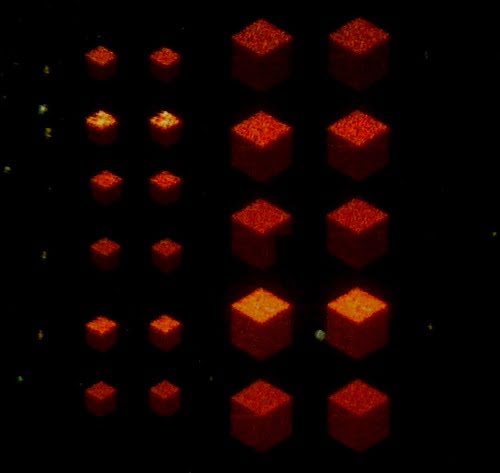A new 2D nanostructured surface has been created that can produce 3D images that are more realistic than holograms and 3D cinema. This could bring a new functionality to small camera lenses, as well as replace heavy optical lenses in applications such as satellites, where weight and size have an impact on efficiency.
Using cutting-edge nanoengineering and metasurfaces, scientists at King’s College London and the University of Bonn in Germany have developed layered materials that use diffuse reflection to control the scattering properties of light. In doing so, the researchers were able to manipulate light in a way that enabled a 2D surface to reflect light just as a 3D object would.

Metasurface created by scientists and researchers at King’s College of London and the University of Bonn in Germany. Courtesy of King’s College London.
Using 3D computer graphics techniques called normal mapping, the researchers fabricated a flat metasurface that imitates lighting and shading effects of a 3D cube.
“Holograms represent 3D photos where lighting and shading of an object or scene is fixed,” said Alexander Minovich, the Royal Society Newton International Fellow at King’s College London. “With the normal mapping technique, the lighting and shading changes similarly to real 3D objects when the illumination source is moved. If you illuminate the structure from the right, bright areas will be on the right and shaded areas on the left. When you bring the light source to the left, the position of the bright and dark areas will change accordingly.”
Unlike holograms, which require a coherent light source such as a laser to be viewed, these novel surfaces manipulate the reflection of normal light so they appear as a realistic 3D object in any light condition and from any angle.
Minovich told Photonics Media that the new technique will not replace holograms, but will complement them.
“Holograms recreate the wavefront of a laser reflected from an object. 3D effects are achieved because of the stereo effect; different eyes receive the scenes from different angles,” he said. “The metasurfaces exploit just another aspect of 3D representation — shading and lighting — similar to the way the volume and depth are represented in 2D projections and drawings.”
For the proof of concept, the researchers designed a cube using the normal mapping technique, which was encoded into the metasurface. When illuminated, the metasurface instantly computed how a 3D representation of the image should look and then displayed it.
The normal mapping demonstrated with the metasurface is a new concept, but it could have important implications for a wide range of optical industries, both in introducing new functionality and making products smaller and lighter.
“The most straightforward application is security features, similar to security holograms,” said Minovich. “In a broader perspective it can be used wherever optical diffusers are needed, like displays and in metrology. It could even be utilized for art and advertising if nanotechnology advances enough to allow quick and affordable fabrication of large area nanostructures.”
The research has been published in the American Chemical Society journal Nano Letters (doi: 10.1021/acs.nanolett.7b01003).